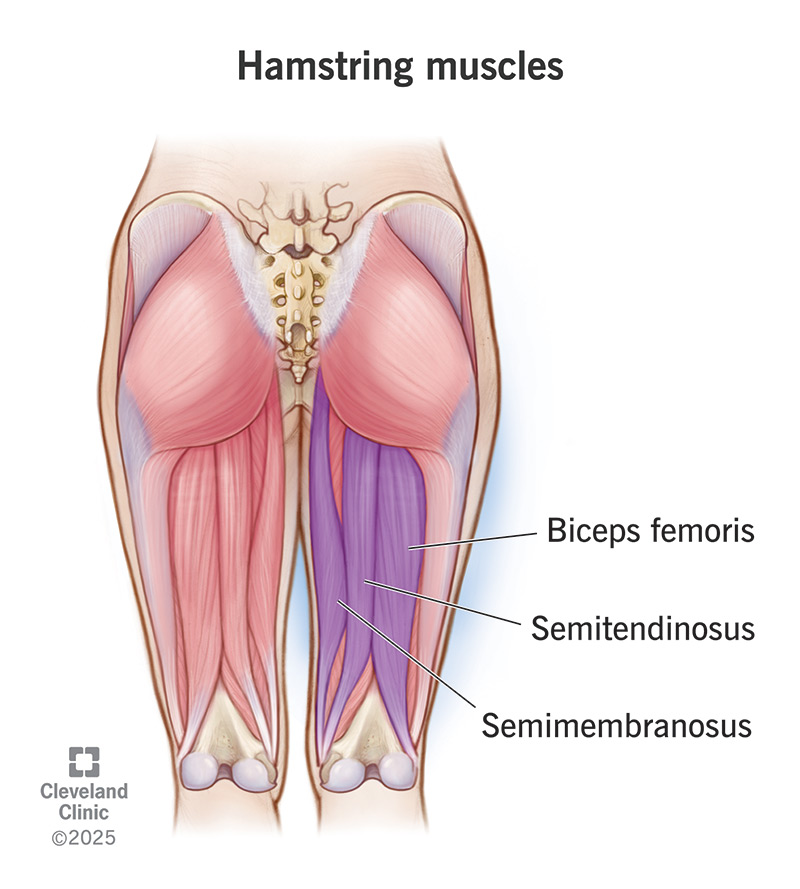Your hamstring muscles are skeletal muscles at the back of your thigh. You use them to walk, climb stairs, do squats and perform many other leg movements. Hamstring injuries are the most common sports injury. Stretching, warming up and not pushing through pain in your hip, knee and leg are the best ways to avoid injuring your hamstrings.
Advertisement
Cleveland Clinic is a non-profit academic medical center. Advertising on our site helps support our mission. We do not endorse non-Cleveland Clinic products or services. Policy

Your hamstring muscles are skeletal muscles. They’re voluntary muscles, meaning you control how they move and work. You have three hamstring muscles at the back of your thigh. You use these thigh muscles to walk, climb stairs, run, do squats and perform many other leg movements.
Advertisement
Cleveland Clinic is a non-profit academic medical center. Advertising on our site helps support our mission. We do not endorse non-Cleveland Clinic products or services. Policy
Hamstring muscles are very susceptible to injury, especially in athletes who run and sprint. Suddenly stopping, slowing down or changing direction puts a lot of strain on these muscles. Extending your leg when running can also overstretch these muscles. A common hamstring injury is called a “pulled hamstring” or strain.
Your hamstring muscles serve a variety of functions, including:
Your hamstrings are located in the back of your thigh, starting at your pelvis and extending to your knee. Hamstring tendons attach them to bones in your pelvis, knee and lower leg.
The three hamstring muscles are:
Your hamstring muscles contain thousands of long, elastic muscle fibers. These fibers help your leg muscles contract, or tighten. So, your hamstrings might look striated (striped) if you could see them under your skin.
Advertisement
Conditions that can affect your hamstring include muscle strains. These can occur as a result of overstretched muscle fibers. Hamstring strains can range from mild to severe. Hamstring strains include:
Hamstring muscle injuries may cause:
Hamstring injuries are common in athletes who run at fast speeds. This includes sprinters and people who play soccer, basketball and football. They can also occur in skiers, skaters, dancers and other athletes who often have their knees bent in deep squat positions.
You’re also at risk for hamstring muscle injuries if you:
Take care of your hamstring muscles by:
Contact your provider right away if you:
Your hamstring muscles play a vital role in helping you walk, run, bend your knees and extend your legs. But these muscles are also very prone to injury, especially if you play soccer or football — or do other activities that require a lot of quick stops and starts. While most hamstring muscle injuries heal with nonsurgical treatments, some require surgery.
You can take care of your hamstrings and reduce your risk of injury by doing proper warm-ups and stretches before physical activity. You should also rest your muscles if you feel pain or fatigue. More importantly, if pain persists in the back of your thigh, seek immediate medical attention.
Advertisement
From sudden injuries to chronic conditions, Cleveland Clinic’s orthopaedic providers can guide you through testing, treatment and beyond.

Last reviewed on 03/23/2025.
Learn more about the Health Library and our editorial process.